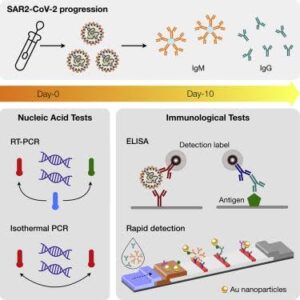Back to: MICROBIOLOGY 300 LEVEL
Welcome to class!
I’m so glad to have you here again! You’re doing exceptionally well, and today’s lesson will help sharpen your scientific thinking even more. We’re learning about Biochemical and Serological Identification—two key ways microbiologists identify bacteria and other microorganisms in the lab. Just like detectives use clues to solve a case, scientists use these tests to figure out exactly what organism is causing an infection. It’s like trying to find out which one of your friends secretly finished the pot of jollof rice—you’ll need evidence!
Biochemical And Serological Identification
Biochemical Identification: Understanding Microbial Behaviour

Biochemical identification is all about observing how a microbe behaves when exposed to certain substances. Microorganisms carry out various chemical reactions as part of their metabolism, and these reactions leave behind unique clues.
These tests help identify:
The enzymes a microorganism produces.
The sugars it can ferment.
The end products of its metabolism.
Common Biochemical Tests
Catalase Test
Tests for the enzyme catalase, which breaks down hydrogen peroxide into water and oxygen.
Example: Staphylococcus aureus (positive) vs. Streptococcus species (negative).
Coagulase Test
Detects the enzyme coagulase, which clots plasma.
Staphylococcus aureus is coagulase positive—it forms clots.
Indole Test
Checks if the organism can break down tryptophan into indole.
Escherichia coli is indole positive.
Urease Test
Determines whether the organism produces urease, an enzyme that breaks down urea.
Proteus species are strongly urease positive.
Sugar Fermentation Tests
Show if bacteria can ferment sugars like glucose, lactose, or sucrose, and what products they produce.
Used to differentiate among Enterobacteriaceae.
Imagine going to Mama Nkechi’s buka where each soup smells different—you can almost tell what’s in each pot without looking, based on the scent. That’s how biochemical tests work—each organism has its own ‘scent’ or pattern of chemical behaviour.
Serological Identification: Using the Immune System’s Clues
Serological identification uses antibodies and antigens to detect microorganisms. Antibodies are proteins the body makes in response to foreign invaders (antigens). Scientists use this natural response to identify pathogens quickly and specifically.
Types of Serological Tests
Agglutination Tests
Antibodies cause antigens (like bacteria) to clump together.
Used to identify blood groups and bacteria like Salmonella.

ELISA (Enzyme-Linked Immunosorbent Assay)
Detects either antigens or antibodies in a sample.
Widely used for diseases like HIV, hepatitis, and COVID-19.
Western Blot
Confirms the presence of specific proteins or antibodies.
Used for HIV confirmation after ELISA.
Rapid Diagnostic Tests (RDTs)
Simple kits used at clinics or in the field.
For example, malaria test kits that detect Plasmodium antigens.
Imagine a tailor identifying your cloth just by the pattern and feel—serological tests are like that. They match antigens with specific antibodies like puzzle pieces.
Summary
- Biochemical identification tests how bacteria behave chemically, using reactions to detect enzymes or fermentation.
- Serological identification uses antibodies to detect pathogens through reactions like agglutination and ELISA.
- Both methods help quickly and accurately identify disease-causing organisms in the lab.
Evaluation
- What is the main difference between biochemical and serological identification?
- Name two examples of biochemical tests and what they detect.
- Give one real-life application of a serological test in medical diagnosis.
These are skills you’ll use for life—as a scientist, healthcare worker, or researcher. You’re learning how to investigate disease at the microscopic level, and that’s incredibly powerful. Keep asking questions, keep growing—Afrilearn is proud to be part of your journey. See you in the next class!
